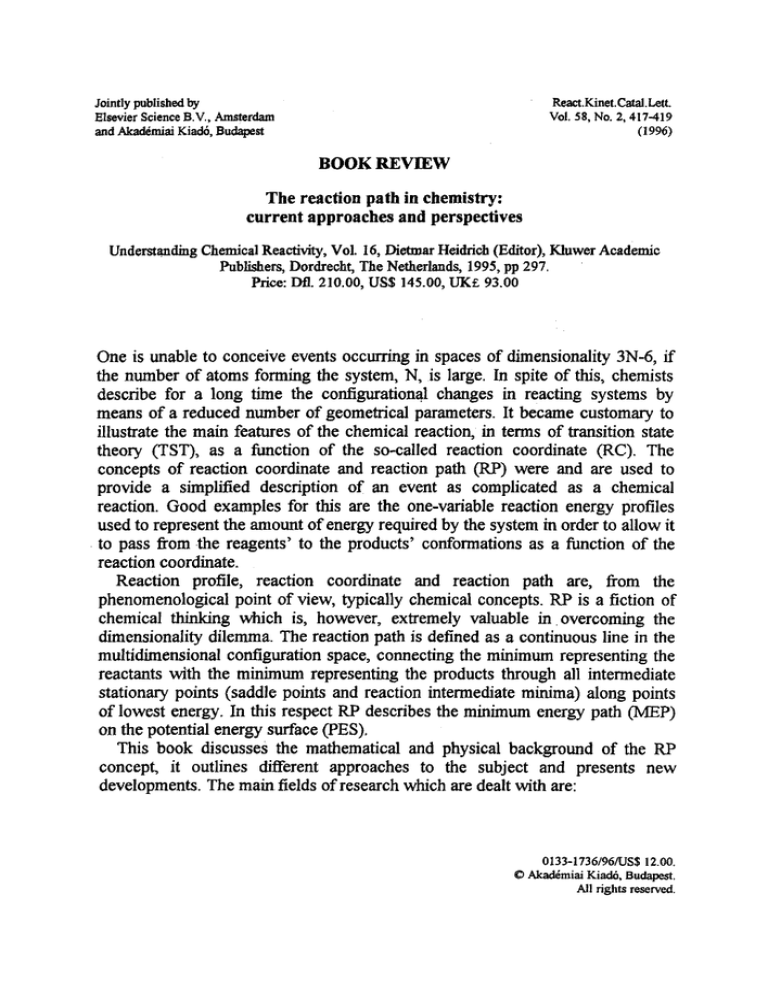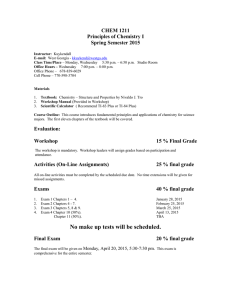
Jointly published by
Elsevier Science B.V., Amsterdam
and Akad~miaiKied6, Budapest
React.Kinet.Catal.Lett.
Vol. 58, No. 2, 417-419
(1996)
BOOK REVIEW
The reaction path in chemistry:
current approaches and perspectives
Understanding Chemical Reactivity, Vol. 16, Dietmar Heidrieh (Editor), Kluwer Academic
Publishers, Dordreeht, The Netherlands, 1995, pp 297.
Price: Dtl. 210.00, US$145.00, U'Ks 93.00
One is unable to conceive events occurring in spaces of dimensionality 3N-6, if
the number of atoms forming the system, N, is large. In spite of this, chemists
describe for a long time the configurational changes in reacting systems by
means of a reduced number of geometrical parameters. It became customary to
illustrate the main features of the chemical reaction, in terms of transition state
theory (TST), as a function of the so-called reaction coordinate (RC). The
concepts of reaction coordinate and reaction path (RP) were and are used to
provide a simplified description of an event as complicated as a chemical
reaction. Good examples for this are the one-variable reaction energy profiles
used to represent the amount of energy required by the system in order to allow it
9to pass from the reagents' to the products' conformations as a function of the
reaction coordinate.
Reaction profile, reaction coordinate and reaction path are, from the
phenomenological point of view, typically chemical concepts. RP is a fiction of
chemical thinking which is, however, extremely valuable i n overcoming the
dimensionality dilemma. The reaction path is defined as a continuous line in the
multidimensional configuration space, connecting the minimum representing the
reactants with the minimum representing the products through all intermediate
stationary points (saddle points and reaction intermediate minima) along points
of lowest energy. In this respect RP describes the minimum energy path (MEP)
on the potential energy surface (PES).
This book discusses the mathematical and physical background of the RP
concept, it outlines different approaches to the subject and presents new
developments. The main fields of research which are dealt with are:
0133-1736/96/US$12.00.
9 Akad~miaiKiad6, Budapest.
All rights reserved.
41 g
BOOK REVIEW
Analysis of potential energy surfaces, the definition and calculation of reaction
paths.
- The further development of reaction theory beyond transition state theory
which use the RP concept.
The theories based on RP and investigations of chemical reactions using these
theories.
The volume consists of 12 chapters written by different authors. The first
chapter is an introduction to the nomenclature and usage of the reaction path
concept (D. Heidrich). In this chapter, def'mitions related to the RP concept are
given and an attempt is made to develop a common language in this field.
The introductory chapter is followed by four others in which basic ideas and
new developments of the reaction path theory are outlined. These deal with the
following topics:
- Fundamental Groups and Symmetry Rules (P. G. Mezey).
- Loose Definitions ofRPs (X. Chapuisat).
Role of Zero Eigenvalues of Rotation in the Cartesian Force Constant Matrix
along RP (A, Tachibana and T. Iwai).
- The lnvariance of the RP Description in any Coordinate system (W. Quapp).
Among these, especially the chapter discussing the loose definition of RPs is
very helpful for those readers who are less experienced with RP theory.
The next three chapters deal with the calculation of potential energy surfaces
and reaction paths:
- Second-Order Methods for the Optimization of Molecular Potential Energy
Surfaces (T, Helgaker, K. Rund and P. R. Taylor).
- Gradient Extremals and their Relation to the Minimum Energy Path (W.
Quapp, O. Imig and D. Heidrich).
- Density Functional Theory-Calculations of PESs and RPs (G. Seifert and K.
Kr0ger).
These chapters are followed by comprehensive discussions of reaction rate
theories based on the RP concept.
Using the RP concept to Obtain Rate Constants from ab initio Calculations (A.
D. lsaacson).
Direct Dynamics Method of the Calculation of Reaction Rates (D. G. Truhlar).
Both of these chapters provide an up to date description of the reaction rate
theories and in addition present some results of their application. These chapters
are of importance for all research workers interested in chemical kinetics.
In chapter last but one, ab initio studies of reaction paths in excited-state
hydrogen-transfer processes are dealt with by A. L. Sobolewski and W.
Domcke. Both the problems and the results of successful applications of the RP
concept in this field are presented which is of great importance in
photochemistry.
-
BOOK REVIEW
419
In the last contribution, an excellent short survey of the spectroscopy of the
transition state, obtained with time-resolved femtoseeond experimental
techniques, is presented. (C. Heier and V. Engel). First the so-called pump/probe
method is described, then some results are presented for the purPose of
illustration.
The book is intended for research workers in theoretical chemistry, molecular
modelling, physical chemistry, kinetics and bio-sciences.
Tibor B6rces
Central Research Institute
for Chemistry, Budapest



